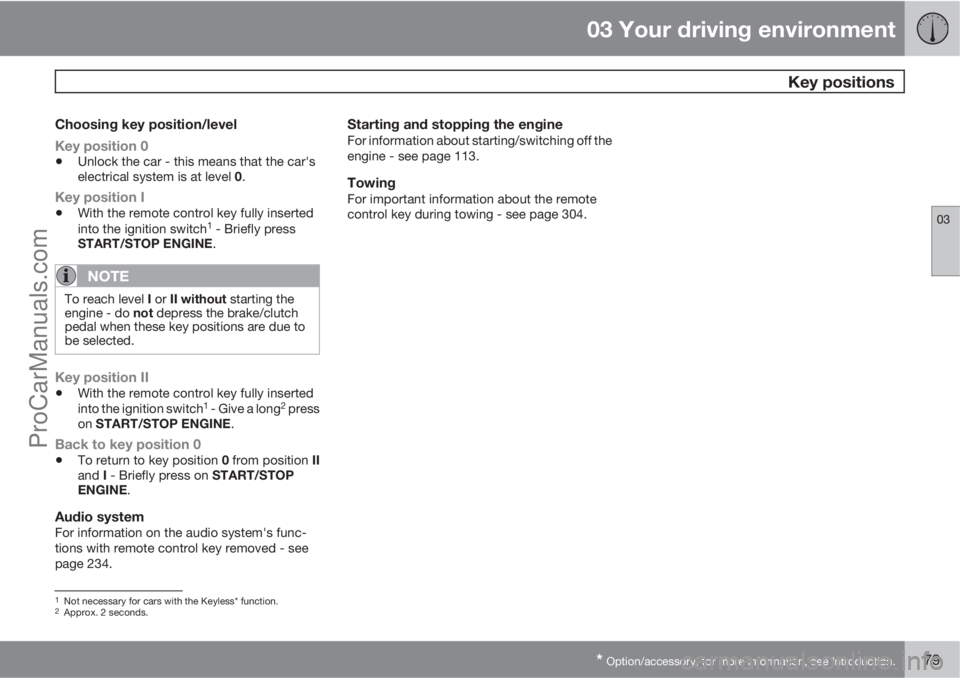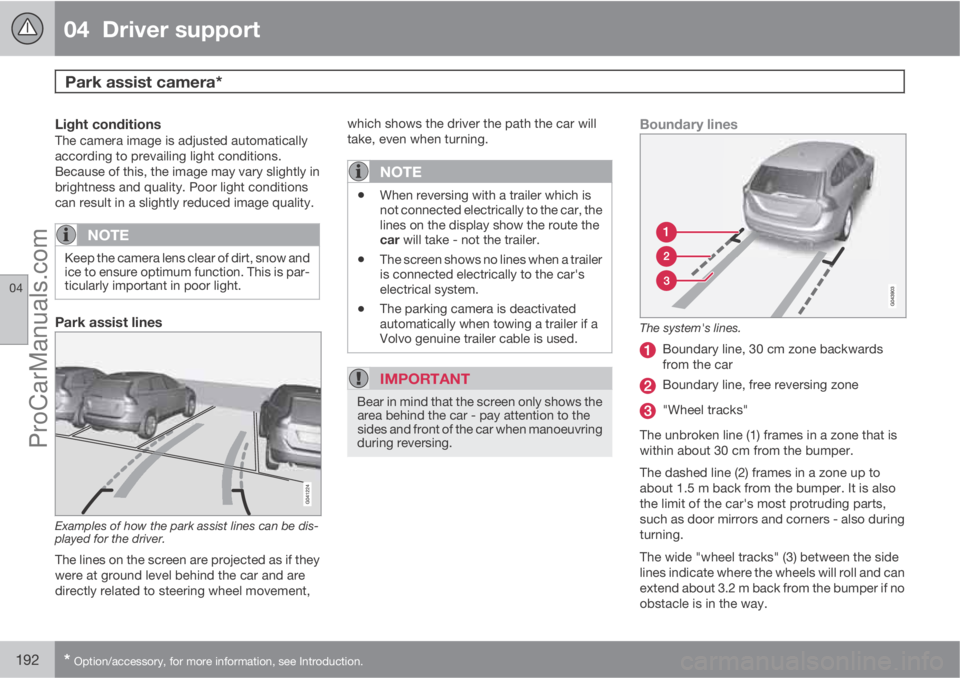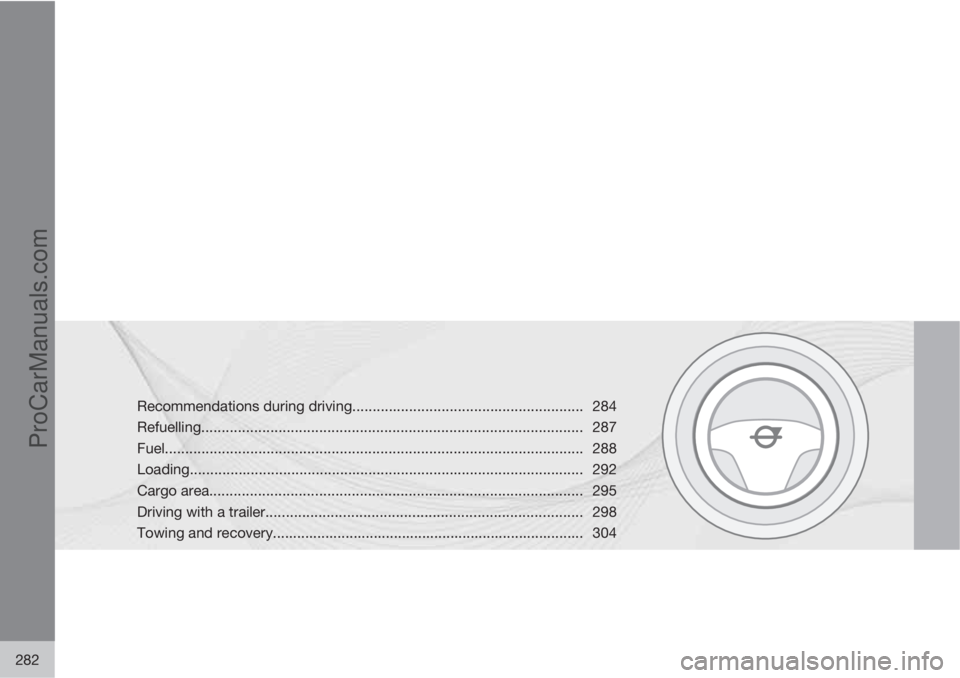2013 VOLVO V60 towing
[x] Cancel search: towingPage 6 of 422

Table of contents
4* Option/accessory, for more information, see Introduction.
06
06 Infotainment system
General information on infotainment...... 234
Radio....................................................... 245
Media player........................................... 252
External audio source via AUX/USB*
input........................................................ 256
Media Bluetooth
�Ÿ* ................................. 259
Bluetooth�Ÿ handsfree*............................262
Voice recognition* mobile phone............ 271
TV*........................................................... 275
Remote control* ..................................... 279
07
07 During your journey
Recommendations during driving........... 284
Refuelling................................................ 287
Fuel......................................................... 288
Loading................................................... 292
Cargo area.............................................. 295
Driving with a trailer................................298
Towing and recovery.............................. 304
08
08 Wheels and tyres
General ................................................... 310
Changing wheels ................................... 314
Tyre pressure ......................................... 317
Warning triangle and first-aid kit*............ 318
Tyre pressure monitoring (TPMS)*.......... 319
Emergency puncture repair (TMK) ......... 321
ProCarManuals.com
Page 81 of 422

03 Your driving environment
Key positions
03
* Option/accessory, for more information, see Introduction.79
Choosing key position/level
Key position 0
•Unlock the car - this means that the car's
electrical system is at level 0.
Key position I
•With the remote control key fully inserted
into the ignition switch1 - Briefly press
START/STOP ENGINE.
NOTE
To reach level I or II without starting the
engine - do not depress the brake/clutch
pedal when these key positions are due to
be selected.
Key position II
•With the remote control key fully inserted
into the ignition switch1 - Give a long2 press
on START/STOP ENGINE.
Back to key position 0
•To return to key position 0 from position II
and I - Briefly press on START/STOP
ENGINE.
Audio systemFor information on the audio system's func-
tions with remote control key removed - see
page 234.
Starting and stopping the engineFor information about starting/switching off the
engine - see page 113.
TowingFor important information about the remote
control key during towing - see page 304.
1Not necessary for cars with the Keyless* function.2Approx. 2 seconds.
ProCarManuals.com
Page 115 of 422

03 Your driving environment
Starting the engine
03
* Option/accessory, for more information, see Introduction.113 Petrol and diesel engines
Ignition switch with remote control key extracted/
inserted. and START/STOP ENGINE button.
IMPORTANT
Do not press in the remote control key incor-
rectly turned - Hold the end with the detach-
able key blade, see page 48.
1. Insert the remote control key in the ignition
switch and press it in to its end position.
Note that if the car is equipped with an
alcolock then a breath test must first be
approved before the engine can be started
- see page 109.2.
Hold the clutch pedal fully depressed
1. (For
cars with automatic gearbox - Depress the
brake pedal.)
3.
Press the START/STOP ENGINE button
and then release it.
The starter motor works until the engine starts
or until its overheating protection triggers.
IMPORTANT
If the engine fails to start after 3 attempts -
wait for 3 minutes before making a further
attempt. Starting capacity increases if the
battery is allowed to recover.
WARNING
Never remove the remote control key from
the ignition switch after starting the engine
or when the car is being towed.
WARNING
Always remove the remote control key from
the ignition switch when leaving the car, and
make sure that the key position is 0 - in par-
ticular if there are children in the car. For
information on how this works - see
page 79.
NOTE
The idling speed can be noticeably higher
than normal for certain engine types during
cold starting. This is so that the emissions
system can reach normal operating tem-
perature as quickly as possible, which min-
imises exhaust emissions and protects the
environment.
Keyless drive*Follow steps 2–3 for starting petrol and diesel
engines. For more information on Keyless drive
- see page 53.
NOTE
A prerequisite for the car to start is that one
of the car's remote control keys with the
Keyless drive* function is in the passenger
compartment or cargo area.
WARNING
Never remove the remote control key from
the car while driving or during towing.
Stop the engineTo switch off the engine:
•Press START/STOP ENGINE - the engine
stops.
1If the car is moving then it is enough to press the START/STOP ENGINE button to start the car.
ProCarManuals.com
Page 127 of 422

03 Your driving environment
Gearboxes
03
* Option/accessory, for more information, see Introduction.125 Automatic gearbox Powershift*
D: Automatic gear positions. +/–: Manual gear
positions.
Powershift is a 6-stage automatic gearbox that
has double mechanical clutch discs in contrast
to a conventional automatic gearbox. A con-
ventional automatic gearbox has a hydraulic
torque converter instead that transfers power
from engine to gearbox.
Powershift transmission operates in the same
way and has similar controls and functions as
the Geartronic automatic transmission, descri-
bed in the previous section.
Powershift or Geartronic?In the event of uncertainty as to whether or not
the car is equipped with Powershift transmis-sion, this can be verified by checking the des-
ignation on the transmission's label under the
bonnet - see page 370. The designa-
tion ”MPS6” means that it is Powershift – trans-
mission otherwise it is Geartronic automatic
transmission.
HSAThe HSA (Hill Start Assist) function means that
the pressure in the brake system remains for
several seconds while the foot is moved from
the brake pedal to the accelerator pedal before
setting off or reversing uphill.
The temporary braking effect releases after
several seconds or when the driver acceler-
ates.
To bear in mindThe transmission's double clutch has overload
protection that is activated if it becomes too
hot, e.g. if the car is held stationary with the
accelerator pedal on an uphill gradient for a
long time.
Overheated transmission causes the car to
shake and vibrate, and the warning symbol illu-
minates and the information display shows a
message. The transmission can also overheat
during slow driving in queues (10 km/h orslower) on an uphill gradient, or with a trailer
hitched. The transmission cools down when
the car is stationary, with foot brake depressed
and the engine running at idling speed.
Overheating during slow driving in queues can
be avoided by driving in stages: Stop the car
and wait with your foot on the brake pedal until
there is a moderate distance to the traffic
ahead, drive forward a short distance, and then
wait another moment with your foot on the
brake pedal.
IMPORTANT
Use the foot brake to hold the car stationary
on an uphill gradient - do not hold the car
with the accelerator pedal. The gearbox
could then overheat.
For important information regarding Powershift
transmission and towing - see page 304.
Text message and actionIn some situations the display may show a
message at the same time as a symbol is illu-
minated.
ProCarManuals.com
Page 191 of 422

04 Driver support
Park assist syst*
04
* Option/accessory, for more information, see Introduction.189
behind and in front of the car, then the tone
sounds alternately from the loudspeakers.
IMPORTANT
Certain objects e.g. chains, thin glossy
poles or low barriers may be in the "signal
shadow" and are then temporarily not
detected by the sensors - the pulsating tone
may then unexpectedly stop instead of
changing over to the expected constant
tone.
•In which case, pay extra attention and
manoeuvre/reposition the car particu-
larly slowly or stop the current parking
manoeuvre - there may be a high risk of
damage to vehicles or other objects
since the sensors are unable to function
optimally.
Rear parking assistance
The distance covered to the rear of the car is
about 1.5 metres. The acoustic signal for
obstacles behind comes from one of the rear
loudspeakers.
Rear parking assistance is activated when
reverse gear is engaged.
The system must be deactivated when revers-
ing with a trailer or bike carrier on the towbar
or similar - otherwise they would trigger the
sensors.
NOTE
Rear parking assistance is deactivated
automatically when towing a trailer if Volvo
genuine trailer wiring is used.
Front parking assistance
The distance covered in front of the car is about
0.8 metres. The acoustic signal for obstacles in
front comes from one of the front loudspeak-
ers.
Front parking assistance is active up to
15 km/h. The lamp in the button is illuminated
in order to indicate that the system is activated.
When the speed is below 10 km/h the system
is reactivated.
NOTE
Front parking assistance is deactivated
when the parking brake is applied or P mode
is selected in a car with an automatic gear-
box.
ProCarManuals.com
Page 194 of 422

04 Driver support
Park assist camera*
04
192* Option/accessory, for more information, see Introduction.
Light conditionsThe camera image is adjusted automatically
according to prevailing light conditions.
Because of this, the image may vary slightly in
brightness and quality. Poor light conditions
can result in a slightly reduced image quality.
NOTE
Keep the camera lens clear of dirt, snow and
ice to ensure optimum function. This is par-
ticularly important in poor light.
Park assist lines
Examples of how the park assist lines can be dis-
played for the driver.
The lines on the screen are projected as if they
were at ground level behind the car and are
directly related to steering wheel movement,which shows the driver the path the car will
take, even when turning.
NOTE
•When reversing with a trailer which is
not connected electrically to the car, the
lines on the display show the route the
car will take - not the trailer.
•The screen shows no lines when a trailer
is connected electrically to the car's
electrical system.
•The parking camera is deactivated
automatically when towing a trailer if a
Volvo genuine trailer cable is used.
IMPORTANT
Bear in mind that the screen only shows the
area behind the car - pay attention to the
sides and front of the car when manoeuvring
during reversing.
Boundary lines
The system's lines.
Boundary line, 30 cm zone backwards
from the car
Boundary line, free reversing zone
"Wheel tracks"
The unbroken line (1) frames in a zone that is
within about 30 cm from the bumper.
The dashed line (2) frames in a zone up to
about 1.5 m back from the bumper. It is also
the limit of the car's most protruding parts,
such as door mirrors and corners - also during
turning.
The wide "wheel tracks" (3) between the side
lines indicate where the wheels will roll and can
extend about 3.2 m back from the bumper if no
obstacle is in the way.
ProCarManuals.com
Page 284 of 422

282
Recommendations during driving......................................................... 284
Refuelling.............................................................................................. 287
Fuel....................................................................................................... 288
Loading................................................................................................. 292
Cargo area............................................................................................ 295
Driving with a trailer.............................................................................. 298
Towing and recovery............................................................................. 304
ProCarManuals.com
Page 300 of 422

07 During your journey
Driving with a trailer
07
298* Option/accessory, for more information, see Introduction.
General
Payload depends on the car's kerb weight. The
total of the weight of the passengers and all
accessories, e.g. towbar, reduces the car's
payload by a corresponding weight. For more
detailed information on weights, see
page 373.
If the towing bracket is mounted by Volvo, then
the car is delivered with the necessary equip-
ment for driving with a trailer.
•The car's towing bracket must be of an
approved type.
•If the towbar is retrofitted, check with your
Volvo dealer that the car is fully equipped
for driving with a trailer.
•Distribute the load on the trailer so that the
weight on the towing bracket complies
with the specified maximum towball load.
•Increase the tyre pressure to the recom-
mended pressure for a full load. For tyre
pressure label location, see page 317.
•The engine is loaded more heavily than
usual when driving with a trailer.
•Do not tow a heavy trailer when the car is
brand new. Wait until it has been driven at
least 1000 km.
•The brakes are loaded much more than
usual on long and steep downhill slopes.
Downshift to a lower gear and adjust your
speed.
•For safety reasons, the maximum permit-
ted speed for the car when coupled with a
trailer should not be exceeded. Follow the
regulations in force for the permitted
speeds and weights.
•Maintain a low speed when driving with a
trailer up long, steep ascents.
•Avoid driving with a trailer on inclines of
more than 12%.
Trailer cableAn adapter is required if the car's towing
bracket has 13 pin electrics and the trailer has
7 pin electrics. Use an adapter cable approved
by Volvo. Make sure the cable does not drag
on the ground.
Direction indicators and brake lights on
the trailer
If any of the trailer's lamps for direction indica-
tors are broken, then the combined instrument
panel's symbol for direction indicators flashes
faster than normal and the display shows the
text
Bulb fail - Ind. signal trailer.
If any of the trailer's lamps for the brake light
are broken then the
Bulb fail - Stop lamp
trailer text is shown.
Level control*The rear shock absorbers maintain a constant
height irrespective of the car's load (up to the
maximum permissible weight). When the car isstationary the rear of the car lowers slightly,
which is normal.
Trailer weightsFor information on Volvo's permitted trailer
weights, see page 374.
NOTE
The stated maximum permitted trailer
weights are those permitted by Volvo.
National vehicle regulations can further limit
trailer weights and speeds. Towbars can be
certified for higher towing weights than the
car can actually tow.
WARNING
Follow the stated recommendations for
trailer weights. Otherwise, the car and trailer
may be difficult to control in the event of
sudden movement and braking.
Manual gearbox
OverheatingWhen driving with a trailer in hilly terrain in a hot
climate there may be a risk of overheating.
•Do not run the engine at higher revolutions
than 4500 rpm (diesel engines: 3500 rpm)
- otherwise the oil temperature may
become too high.
ProCarManuals.com